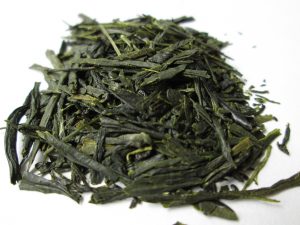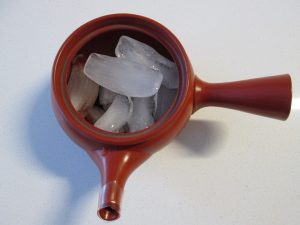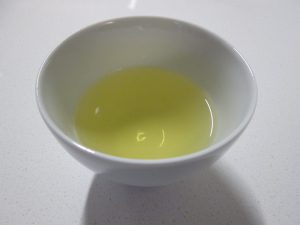 I’m sure that you’re familiar with iced tea, but did you know that you can brew tea using ice only?
I’m sure that you’re familiar with iced tea, but did you know that you can brew tea using ice only?
Ice brewing, or ice steeping, is called kooridashi (氷出し) in Japanese.
I searched on online Japanese pages but it looks like there’s no specific guidelines (in regards to tea/ice ratio) for ice brewing.
This is the first time that I try it. I’ll be ice brewing gyokuro, but you can ice brew sencha as well.
The science behind ice brewing
Why brew with ice at all, and what’s the difference?
Tea leaves will steep in water no matter the temperature. If you use very cold water, you’ll still be able to brew, it just takes longer than if you used hot water.
However, the different compounds in tea are extracted at different rates depending on the temperature:
- Caffeine is highly soluble in hot water, but not so in cold water. Caffeine adds bitterness to tea, especially when combined with a high amount of catechins.
- Catechins are mainly responsible for astringency and also some bitterness (depending on the type of catechin) and they are also very soluble in hot water.
- Amino acids in tea (especially L-theanine) are moderately soluble in cold water, and they add sweetness and umami.
The reason gyokuro is normally brewed at low temperatures, is to suppress the extraction of caffeine and catechins while maximizing L-theanine content during the 2 ~ 3 minutes of steeping time.
When ice brewing gyokuro, the leaves will begin to steep as it melts, so after a relatively long time (depending on the ambient temperature) you’ll have a tea low in astringency and bitterness but with some sweetness and a brothy taste.
Why not brew bancha and houjicha in this way too? Because these teas don’t have a significant l-theanine content in the first place 🙂
Let’s start ice brewing!
 I’ll be ice brewing one cup of gyokuro for myself, so I’ll use the appropriate amount of tea: 4 grams (1 teaspoon). You can add more or less if you want, remember that this isn’t really an exact process.
I’ll be ice brewing one cup of gyokuro for myself, so I’ll use the appropriate amount of tea: 4 grams (1 teaspoon). You can add more or less if you want, remember that this isn’t really an exact process.
I placed the tea inside my kyusu, and then added a fair amount of ice. Bear in mind that my kyusu is very small, it’s for personal use, not for serving to more people.
The amount of ice itself won’t make a big amount of water when it melts, because water expands as it freezes. Again, there isn’t really an exact number for the quantity of ice, see what works best for you.
Using good quality water for your ice is best. If it’s coming from the freezer, rinse it with water before using it. That way you’ll wash any additional taste and smell that it may have caught there.
There’s no need to put the kyusu’s lid. Actually, you don’t even need a kyusu at all, it can even be done in a glass. I’m just doing it that way to give me an idea of the amount of ice required.
Next comes the time for patience. It took about 3 hours for the ice to melt!
 Once it’s done, serve and enjoy!
Once it’s done, serve and enjoy!
About the taste
I found the tea to have very little aroma (perhaps because it was so cold?) but the taste was good, similar to when it’s normally brewed. The color seems the same too.
The astringency and bitterness where toned down as expected, but I found a greater vegetable taste. I was hoping for a little more thickness and sweetness. Perhaps I used too little ice?
Although it takes a long time, it’s a fun way to brew every now and then, especially for a hot day.

May 23, 2013
You have me very interested and I will do this myself. You really grabbed my attention when you discussed the science behind the different ways of making tea. Great post and thank you for sharing. 🙂